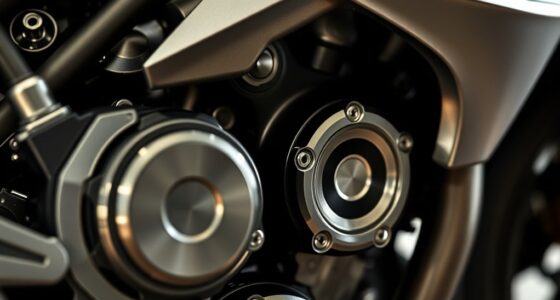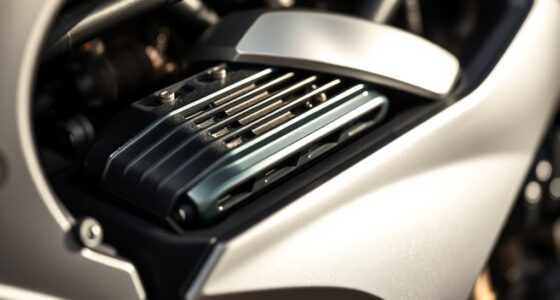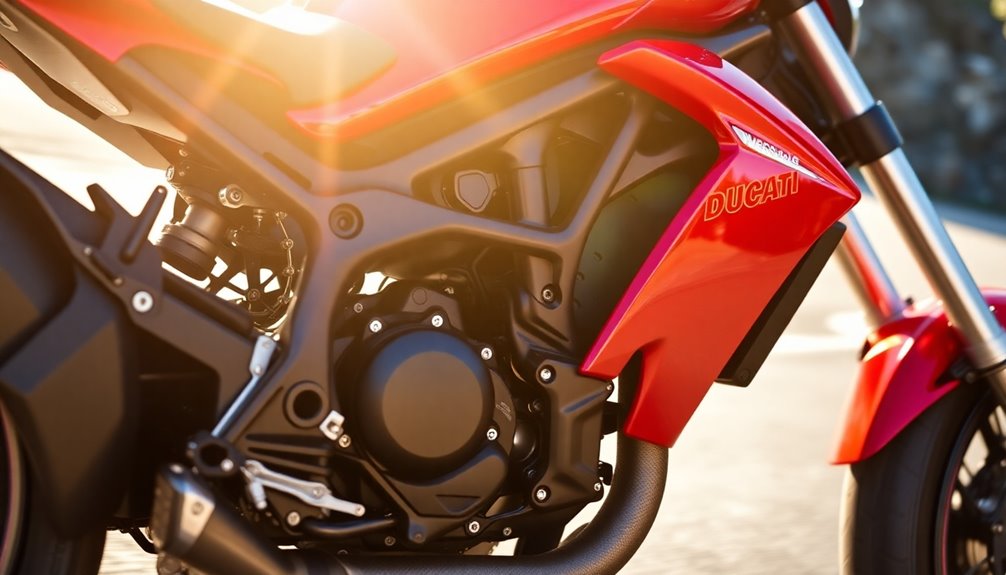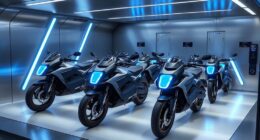If you’re riding rough terrain, your choice between Harley’s air-cooled and liquid-cooled engines impacts durability and maintenance. Air-cooled engines are simpler, built to handle rugged conditions with fewer vulnerable parts, making repairs easier on the trail. Liquid-cooled engines maintain consistent temperature, offering better cooling during long or hot rides but with more components exposed to debris. To discover which system best suits your off-road adventures, keep exploring the details behind each setup.
Key Takeaways
- Air-cooled Harley engines are more durable and easier to repair, ideal for rugged terrain with debris exposure.
- Liquid-cooled Harley engines maintain consistent temperatures, reducing overheating during long or intense off-road rides.
- Air-cooled systems have fewer vulnerable parts, lowering damage risk from rocks and mud in rough environments.
- Liquid-cooled engines may require more maintenance but offer better cooling efficiency in extreme conditions.
- The choice depends on balancing ease of maintenance and durability versus superior cooling for challenging terrains.

When choosing a Harley-Davidson motorcycle, understanding the differences between air-cooled and liquid-cooled engines can considerably impact your riding experience. For riding on rough terrain, these differences become even more significant, especially when it comes to engine cooling and maintenance. Air-cooled engines rely on airflow to regulate temperature, which means they’re simpler, with fewer parts to worry about. This simplicity can be a major advantage when tackling off-road conditions, where durability and ease of maintenance matter most. You won’t have to deal with radiators or coolant levels, and the engine’s design allows for quick repairs if you encounter a problem on the trail. However, you should be aware that air-cooled engines tend to run hotter in extreme conditions, potentially leading to overheating during prolonged rides on rugged terrain.
On the other hand, liquid-cooled engines use a cooling system that circulates coolant through the engine to maintain optimal temperature. This system generally provides better engine cooling, especially during long rides or in hot weather, which can be a real plus when steering through challenging terrain. You’ll notice that liquid-cooled engines maintain a more consistent operating temperature, reducing the risk of overheating and engine stress. But keep in mind that this setup involves additional components like radiators, hoses, and a water pump. These parts can be vulnerable to damage from rocks, mud, or debris kicked up during off-road adventures, leading to increased maintenance. The fluid system also requires regular checks and occasional refills, adding to the maintenance differences you’ll need to stay on top of for reliable performance in rough conditions.
Additionally, engine cooling technology plays a crucial role in determining how well your motorcycle performs in demanding environments, making it an important factor to consider in your choice. In terms of maintenance differences, air-cooled engines are generally easier to service because they have fewer parts and less complexity. You might spend less time on routine checks, but you’ll need to pay attention to engine fins and airflow paths to prevent overheating. With liquid-cooled engines, you’ll need to monitor coolant levels, inspect radiators for damage, and flush the system periodically. While the added complexity might seem like a hassle, it often translates into better engine longevity and consistent performance during demanding rides. For off-road adventures, your choice hinges on balancing ease of maintenance with the need for effective cooling. If you prefer a simpler setup that’s tough and straightforward, air-cooled might be the way to go. If you want maximum cooling efficiency and don’t mind extra upkeep, liquid cooling could serve you better on the roughest terrains.
Frequently Asked Questions
How Does Cooling Efficiency Affect Maintenance Frequency?
Cooling efficiency directly impacts maintenance frequency, as better cooling system longevity means fewer parts wear out or fail. You’ll spend less on maintenance costs because efficient cooling reduces overheating issues, which often cause engine damage. With a reliable cooling system, you avoid frequent repairs and keep your ride running smoothly longer. Investing in a system with high cooling efficiency ultimately saves you time and money over the vehicle’s lifespan.
Which System Performs Better in Extreme Cold Conditions?
In extreme cold conditions, a liquid-cooled system performs better because it manages engine heat dissipation more effectively. Coolant viscosity remains stable, allowing consistent heat transfer, even in low temperatures. This prevents engine components from freezing or overheating. You’ll notice smoother operation and fewer cold-start issues. Conversely, air-cooled engines may struggle as their heat dissipation relies solely on ambient air, which is less reliable in extreme cold.
Are There Weight Differences Impacting Off-Road Handling?
The weight difference between air-cooled and liquid-cooled systems can impact your off-road handling. Heavier engines, like some liquid-cooled setups, may reduce handling stability, making maneuvering trickier on rough terrain. Conversely, lighter air-cooled engines can enhance agility and control. Consider how weight impact influences your riding style and terrain to choose the system that offers better handling stability for your adventures.
How Does Cooling System Choice Influence Fuel Efficiency?
Your cooling system choice directly impacts fuel efficiency through thermal regulation efficiency. Liquid-cooled systems generally maintain ideal engine temperatures more consistently, which can improve fuel economy by reducing engine strain. Air-cooled systems, while simpler, may experience temperature fluctuations that cause the engine to work harder, lowering efficiency. So, if you want better fuel economy and more consistent thermal regulation, a liquid-cooled system is typically the better choice for rough terrain riding.
What Are the Long-Term Durability Differences Between Systems?
You’ll find that air-cooled engines often last longer because they have fewer components prone to failure, boosting engine longevity. However, liquid-cooled systems typically offer better corrosion resistance due to their sealed design, reducing rust over time. A stat shows that properly maintained air-cooled engines often reach 100,000 miles, while liquid-cooled engines tend to maintain peak performance longer in harsh environments. Your choice impacts durability based on these factors.
Conclusion
When choosing between Harley’s air-cooled and liquid-cooled engines for rough terrain, consider how each handles heat and performance. Did you know that liquid-cooled engines can run 20% cooler under intense conditions, making them better suited for tough trails? Ultimately, if you want durability and simplicity, air-cooled might be your pick. But if you crave consistent performance in extreme conditions, liquid-cooled engines could be the smarter choice for your adventures.








